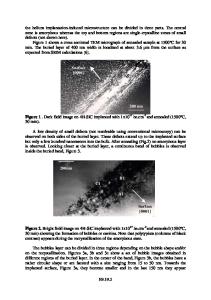Suppression of Secondary Defects in Silicon by Carbon Implantation
- PDF / 399,405 Bytes
- 6 Pages / 414.72 x 648 pts Page_size
- 102 Downloads / 374 Views
Abstract We have examined the role of co-implanted carbon in suppressing the formation of secondary defects in self-ion irradiated Si(100). Implantation of 540 keV energy Si ions to a fluence of 10"5 cm 2 followed by a 900'C, 15 minute anneal leads to the growth of an extended defect band at the end-of-range. Range matched carbon co-implantation can be used to modify this defect development dramatically. While direct co-implantation of carbon and silicon ions has no apparent effect on the formation of extended defects, such formation can be suppressed when the implanted C is incorporated substitutionally into the silicon lattice. Ion channelling and nuclear reaction analysis show that substitutional carbon is removed from substitutional sites during Si ion irradiation. In this case, it is proposed that excess interstitial silicon ions which normally lead to the growth of secondary defects will occupy the lattice sites previously occupied by carbon ions.
Introduction Results from experiments with ion-irradiated silicon suggest that mobile silicon interstitials, formed inevitably in the implantation process, play an important role in the growth of extended defects at the implant end-of-range during annealing(1,2). The release at T>7000 C of silicon interstitials from transient defect clusters such as the {311} rod-like defect etc. (3,4) is believed to be the source of defects driving the formation of dislocations at higher anneal temperatures. Similarly, the transient enhanced diffusion of boron in ion-implanted silicon is attributed to the formation of boron interstitials, a process that depends on a flux of silicon interstitials to the substitutional B sites(5). Any process driven by the interstitial flux can be inhibited by the introduction of interstitial traps. Such an effect has been reported by Stolk et al. in MBE grown silicon (6): the transient enhanced diffusion (TED) of boron from 8-doped markers in Si ion-irradiated silicon was suppressed when the silicon contained grown-in (substitutional) C concentrations of order 10' 9 cm3, an effect explained through the trapping of Si interstitials to C. C implantation into silicon, 16 followed by annealing, does not produce secondary defects even for fluences as high as 2x10 2 cm at 3 MeV (7). Again, it is believed that the Si interstitials which would normally drive defect development are removed by co-precipitation with C atoms. There have also been several reports of dislocation suppression by carbon co-implantation with non-Si implant species (8-11). Tamura et al (8) were able to reduce the formation of dislocations generated by a 1015 cm"2, 1.5 MeV Pimplant by co-implanting C to a fluence of 5x1015 cm' 2 ; however, little effect was observed for a C fluence of lxl 0'5 cm 2 , indicating that the efficiency of carbon in removing the excess interstitials from the P-implant was much less than 100%. Nishikawa and Yamaji (10) showed that the secondary defects which form at the amorphous/crystal (a/c) interface during the annealing of a self-ion amorphized layer are
Data Loading...
